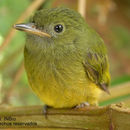en
names in breadcrumbs


Perception Channels: visual ; tactile ; acoustic ; chemical
US Federal List: no special status
CITES: no special status
IUCN Red List of Threatened Species: least concern
Unlike other flycatchers who hawk insects, the Ochre-bellied Flycatcher gleans or picks small insects off leaves from vines, mistletoes, or trees. Fruits comprise far more of this bird's diet than other flycatchers. (Campbell and Lack 1985; Hilty & Brown 1986; Stiles and Skutch 1990)
The Ochre-bellied Flycatcher, Mionectes oleagineus, can be found south of Mexico to the west of Ecuador, Bolivia and Amazon Brazil. (Stiles and Skutch 1990)
Biogeographic Regions: neotropical (Native )
The Ochre-bellied Flycatcher prefers humid forests, second growth woodland, semi-open clearings with scattered trees near woodland forages, and often along forest streams. The Ochre-bellied Flycatcher can also be found in sandy-belt forests of the extreme east. (Hilty & Brown 1986; Stiles and Skutch 1990)
Terrestrial Biomes: savanna or grassland ; rainforest
The Ochre-bellied Flycatcher is 12.5 cm (5 in) in height and weighs 13 g (.5 oz). This Flycatcher is slender and has a small head. The bill is narrow and shaped like a cylinder. Yellow or orange mouth corners are found only on males. The back of the bird is olive green. Its belly is ochre, or orange-yellow, with a touch of olive at the throat. The Ochre-bellied Flycatcher has two faint ochre wing bars which help identify it from similar species. The wings and tail are brownish and have a thin ochre color around the edges. The males' three outer wing feathers, especially the farthest, are narrowed and pointed at the tip. The young are similar to the adults except their bellies are paler and more yellow. The wing-coverts, a feather covering the bases of the quills of the wings, and the tertials, feathers closest to the body, are thinly tipped and edged with ochre. (Dunning 1987; Hilty & Brown 1986; Stiles and Skutch 1990)
Average mass: 13 g.
Other Physical Features: endothermic ; bilateral symmetry
These birds are polygamous. Courtship occurs between the months of March and July. When courting, up to six males will perch in a shaded understory, 15-50 m (50-160 ft) away from each other and start singing. The song may sound a little like this "whip wit whip wit wit chipchip chip chip chip chip," or "pik ch'wik pik ch'wik ch'wik K-WIT-K'WIT-K'WIT-K'WIT." This bird does not form pair bonds. The male will sit with the other five and wait for a female. After she has mated he will fly to another group and wait for another female. After mating the female bird is on her own. She builds and tends the nest alone and often leaves the nest to find food. She lays 2-3 white eggs. The incubation time for the eggs is 14-20 days. Fledging is 14-23 days after hatching. (Campbell and Lack 1985; Hilty & Brown 1986; Stiles and Skutch 1990)
Key Reproductive Features: iteroparous ; gonochoric/gonochoristic/dioecious (sexes separate); sexual ; oviparous